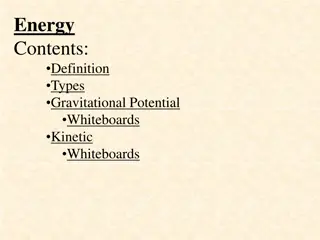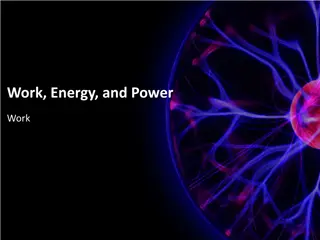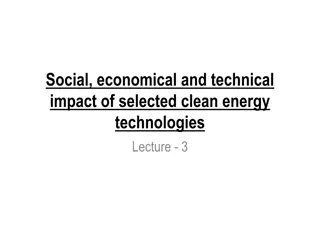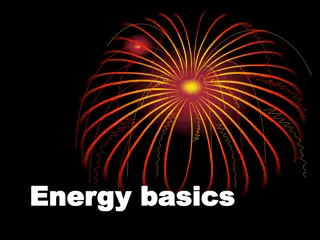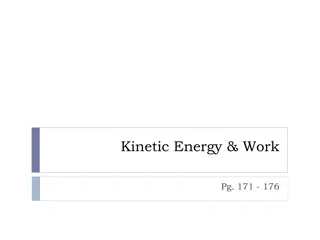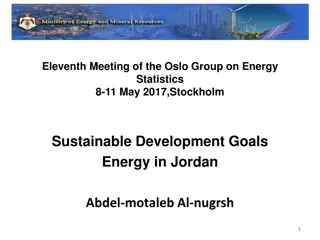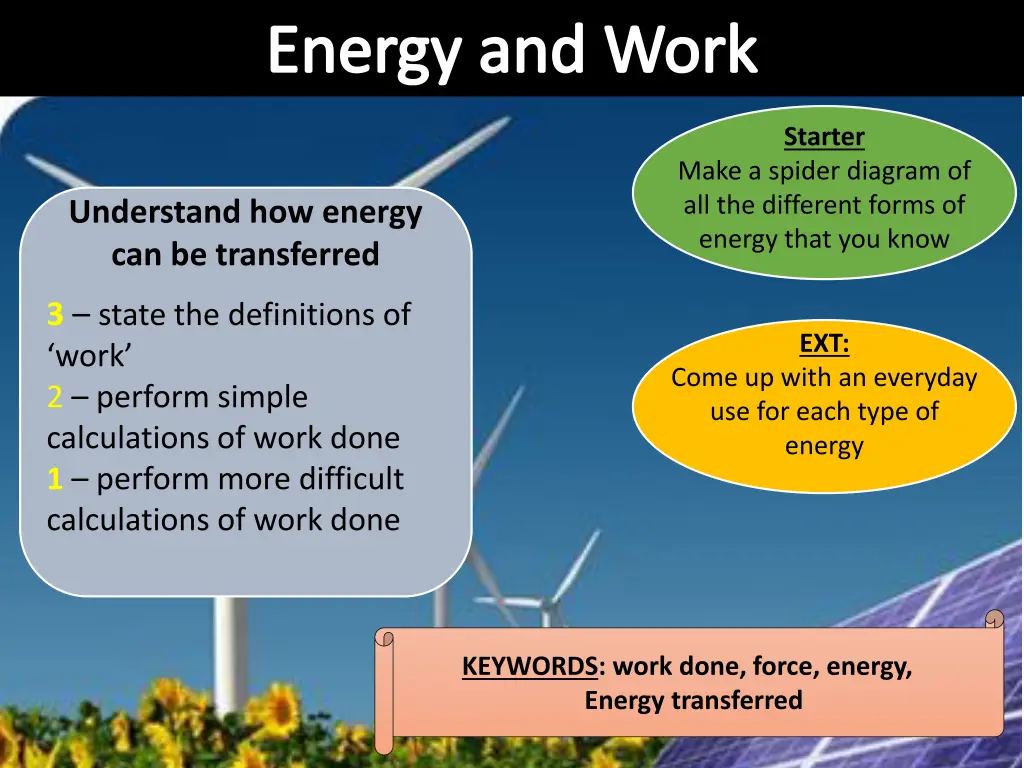
Forms of Energy and Work Principles
Explore the various forms of energy, learn about energy transfer, understand the concept of work, perform work calculations, and apply energy principles in everyday scenarios with practical examples.
Download Presentation

Please find below an Image/Link to download the presentation.
The content on the website is provided AS IS for your information and personal use only. It may not be sold, licensed, or shared on other websites without obtaining consent from the author. If you encounter any issues during the download, it is possible that the publisher has removed the file from their server.
You are allowed to download the files provided on this website for personal or commercial use, subject to the condition that they are used lawfully. All files are the property of their respective owners.
The content on the website is provided AS IS for your information and personal use only. It may not be sold, licensed, or shared on other websites without obtaining consent from the author.
E N D
Presentation Transcript
Energy and Work Starter Make a spider diagram of all the different forms of energy that you know Understand how energy can be transferred 3 state the definitions of work 2 perform simple calculations of work done 1 perform more difficult calculations of work done EXT: Come up with an everyday use for each type of energy KEYWORDS: work done, force, energy, Energy transferred
FORMS OF ENERGY
Think, pair, share Think, pair, share WORK
LO: understand how energy can be transferred What is work? What is work? An object is said to have done WORK when it transfers (uses) energy
PRACTICAL 1. Measure the length of your forearm, this is the distance for one repetition. 2. Multiple this distance by 20 to get total distance. 3. Time how long it takes to do 20 reps of a tray with 10N in (1kg). 4. Repeat with 20-50N (2-5kg). Distance (m) Force (N) Work done (J) Time (S) Power (W) 4.2 10 16 4.2 20 16 4.2 30 16 4.2 40 15 4.2 50 14
LO: understand how energy can be transferred Calculating work Calculating work 1. What are the units of work done, force and distance? 2. Rearrange so force = 3. Rearrange so distance = Work done = force x distance W = f x d W = work done(J) f = force (N) d = distance(m) Force = Work/distance Distance = work/force
LO: understand how energy can be transferred Example 1 Example 1 - - easier easier An object of weight 40N is raised by a height of 0.5m. Calculate the work done in raising the object. Work = force x distance Work = 40N x 0.5m Work = 20J
LO: understand how energy can be transferred Example 2 Example 2 - - harder harder 2000J of energy is transferred by a sprinter as he runs a distance of 100m. Calculate the force that is exerted by the sprinter as he is running. Force = work/distance Force = 2000J / 100m Force = 20N
Easier Problems Harder problems Amy uses 20N of force to push a lawn mower 10 meters. How much work does she do? 700J of energy is used by a person to move 10m. What is the force exerted by the person as they walk the distance? The engine of a car has a force of 750N. How much energy would be transferred by the engine if the car moves 100m? A person does 2000 J of work. What distance do they move if they exerts a force of 200 N? An object of weight 50N is raised by a height of 200cm. What is the work done in raising the object? A person does 1000 J of work. What distance do they move if they are pushed with a force of 50 N? How much work is done if a man weighs 750 N and uses the stairs to climb 50 m? A person does 2000 J of work. What distance do they move if the person uses a force of 0.8 N? How much work is done if a woman lifts a 400 N rucksack onto her back, a height of 1.2 m? Joe balances a stationary coin on the tip of his finger 20cm from the top of the table. How much work is Joe doing? How much work is done if a pebble of weight 0.2 N is thrown 5 m into the air? Object A has a weight of 200N. Object B has a weight of 350N. If 1000J of energy is used to raise each object, which object will gain the most height?
Power Starter Knowledge check Understand how energy can be transferred 3 state the definition of power 2 perform simple calculations of power 1 perform more difficult calculations of power KEYWORDS: work done, force, energy, Energy transferred, power
KNOWLEDGE CHECK Start Timer 3 What is the definition and equation for work done work done 5 Minutes 10 8 Calculate the work done if you throw a ball with force 20N a distance of 20m. 2 6 4 Calculate the Force produced by a car if it takes 20,000J to drive 2km . 1 2 0
Think, pair, share Think, pair, share POWER
LO: understand how energy can be transferred Calculating power Calculating power Power is the amount of work done/energy transferred in a given time Power = work done / time P = W / t P = power (W) W = work done (J) t = time (s)
LO: understand how energy can be transferred Example Example 1 1 - - easy easy A runner does 600 J of work in 2 seconds, what is the power?
LO: understand how energy can be transferred Example Example 2 2 - - harder harder An object of weight 700N is raised by a height of 2m in a time of four seconds. Calculate the work done in raising the object and the power.
Easier Problems Harder problems A car engine transfers 3000J in 20 seconds. What is the power generated by the engine? A kettle has a power rating of 2000W. How much work is done by the kettle in boiling water in 40 seconds? 400J of energy is transferred in raising an object in 60 seconds. What is the power? How much work is done by a 50 kW car engine in 1 minute? The work done by the electric motor is 4000 J and it is running for 80 seconds, what is the power? A student of weight 500N transfers 2000J whilst running up some stairs. She reaches the top of the stairs in 3 seconds. How high are the stairs and what is her power? Electrical energy transferred from the motor is 12250 J, it is used for 125 seconds. What is the power? A sprinter can generate 150W whilst running. If he transfers 450J of energy, how long has he been running for? A crane lifts a load weighing 3000 N through a height of 5 m in 10 s. What is the power of the crane? A girl times herself running up a flight of stairs. Use the data below to work out her useful power. A car engine does 4200 kJ of work in one minute. What is the power output in kilowatts? Number of steps = 28 Height of each step = 0.2m Time taken = 5 s Mass of student = 500N
LO: understand the structure of an atom Practical Practical - - Power Power Aim: To calculate the power required for you to run up the stairs Method: 1. Work out your weight (your mass x 9.81) 2. Run up the stairs as fast as you can 3. Work out the energy transferred as you run up the stairs (your weight x height of stairs) 4. Work out your power (work done / time)



